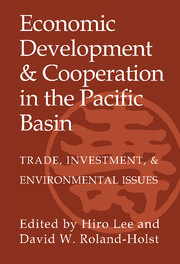 Economic Development and Cooperation in the Pacific Basin
Economic Development and Cooperation in the Pacific Basin Book contents
- Frontmatter
- Contents
- Acknowledgments
- List of Contributors
- I Introduction and Overview
- II U.S.-Japan and Asian Trade Patterns
- III Regional Trading Arrangements in the Pacific Basin
- IV Foreign Direct Investment: Determinants and Consequences
- 7 The Determinants of Foreign Direct Investment: A Survey with Applications to the United States
- 8 Are Trade and Direct Investment Substitutes or Complements? An Empirical Analysis of Japanese Manufacturing Industries
- 9 Korea's Outward Foreign Direct Investment and the Division of Labor in the Asia-Pacific
- 10 China's Absorption of Foreign Direct Investment
- 11 The Impact of Foreign Investment in Indonesia: Historical Trends and Simulation Analysis
- V Trade, Resources, and the Environment
- Index
11 - The Impact of Foreign Investment in Indonesia: Historical Trends and Simulation Analysis
Published online by Cambridge University Press: 19 May 2010
- Frontmatter
- Contents
- Acknowledgments
- List of Contributors
- I Introduction and Overview
- II U.S.-Japan and Asian Trade Patterns
- III Regional Trading Arrangements in the Pacific Basin
- IV Foreign Direct Investment: Determinants and Consequences
- 7 The Determinants of Foreign Direct Investment: A Survey with Applications to the United States
- 8 Are Trade and Direct Investment Substitutes or Complements? An Empirical Analysis of Japanese Manufacturing Industries
- 9 Korea's Outward Foreign Direct Investment and the Division of Labor in the Asia-Pacific
- 10 China's Absorption of Foreign Direct Investment
- 11 The Impact of Foreign Investment in Indonesia: Historical Trends and Simulation Analysis
- V Trade, Resources, and the Environment
- Index
Summary
INTRODUCTION
Foreign investment in Indonesia is best understood in a historical and geographical context. The phenomena of “exportorientation” and “import-substitution,” the resulting dual economy, the assimilation of “capitalism,” utilization of the country's comparative advantage (natural resource base), protection measures such as import quotas, and concerns over income distribution and regional disparities all have definite historical antecedents in this country.
Having gone through a colonial rule for three centuries, it is not unusual for a country like Indonesia to experience some distrust toward external influence, including foreign capital and investment. This perception prevailed after independence in 1945, although it was muted considerably when the New Order government came to power in 1966. Residual suspicion continued among certain groups of society until the late 1970s, but today's opponents of foreign capital are confined to two types. The first is a small group of vested domestic interests seeking to protect markets rather than foster xenophobia. A second group, more recent and politically active, consists of pressure groups concerned with the social and welfare (distributional) impact of foreign investment. These social interest groups were a significant impediment to the dramatic policy changes of the mid-1980s.
The objectives of this chapter are twofold: to delineate the historical context for modern Indonesian foreign investment policy, and to elucidate the impacts of foreign investment on the country's overall welfare and its distribution between household groups and across regions. The chapter is organized as follows. The next section is devoted to a survey of Indonesia's historical experience with foreign capital and investment, from the 1500s up to the late 1970s.
- Type
- Chapter
- Information
- Economic Development and Cooperation in the Pacific BasinTrade, Investment, and Environmental Issues, pp. 351 - 402Publisher: Cambridge University PressPrint publication year: 1998
